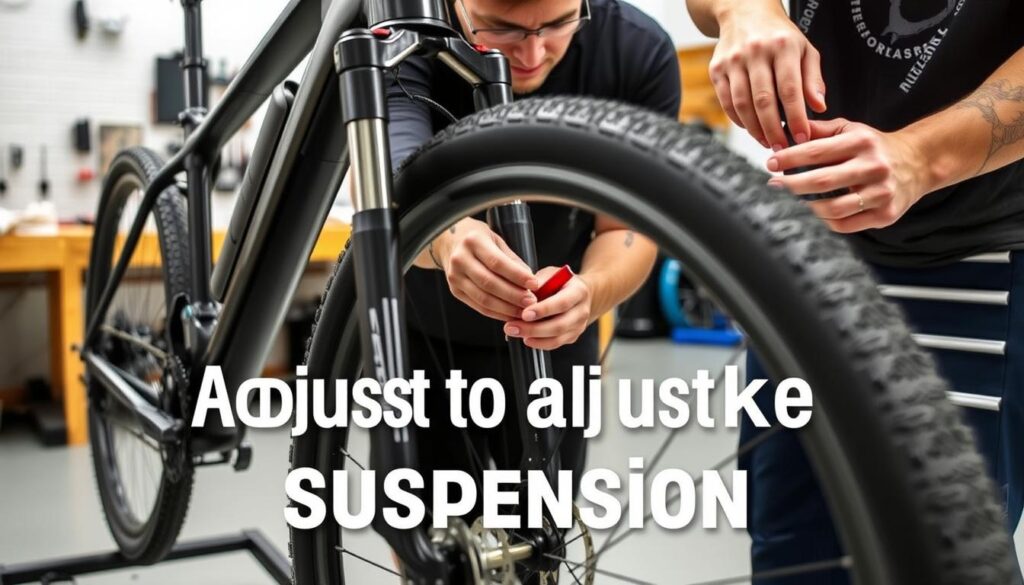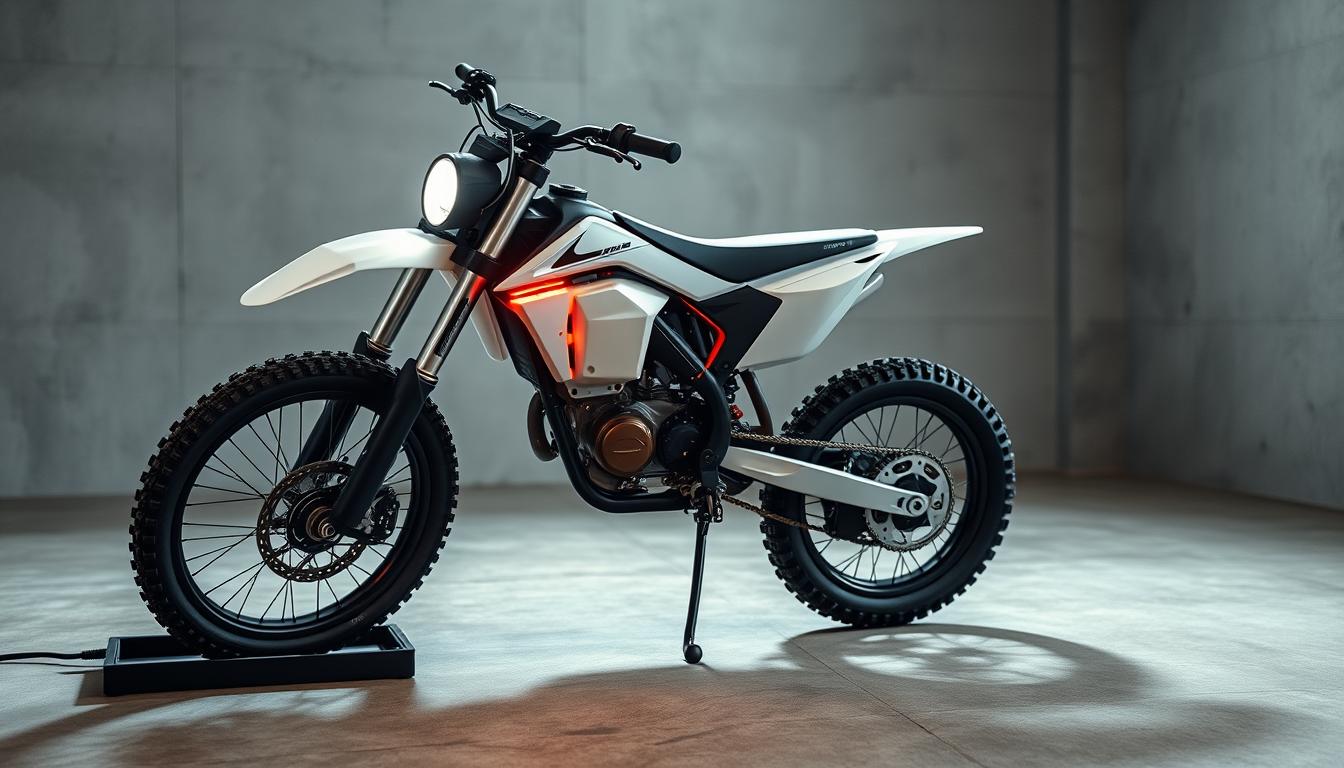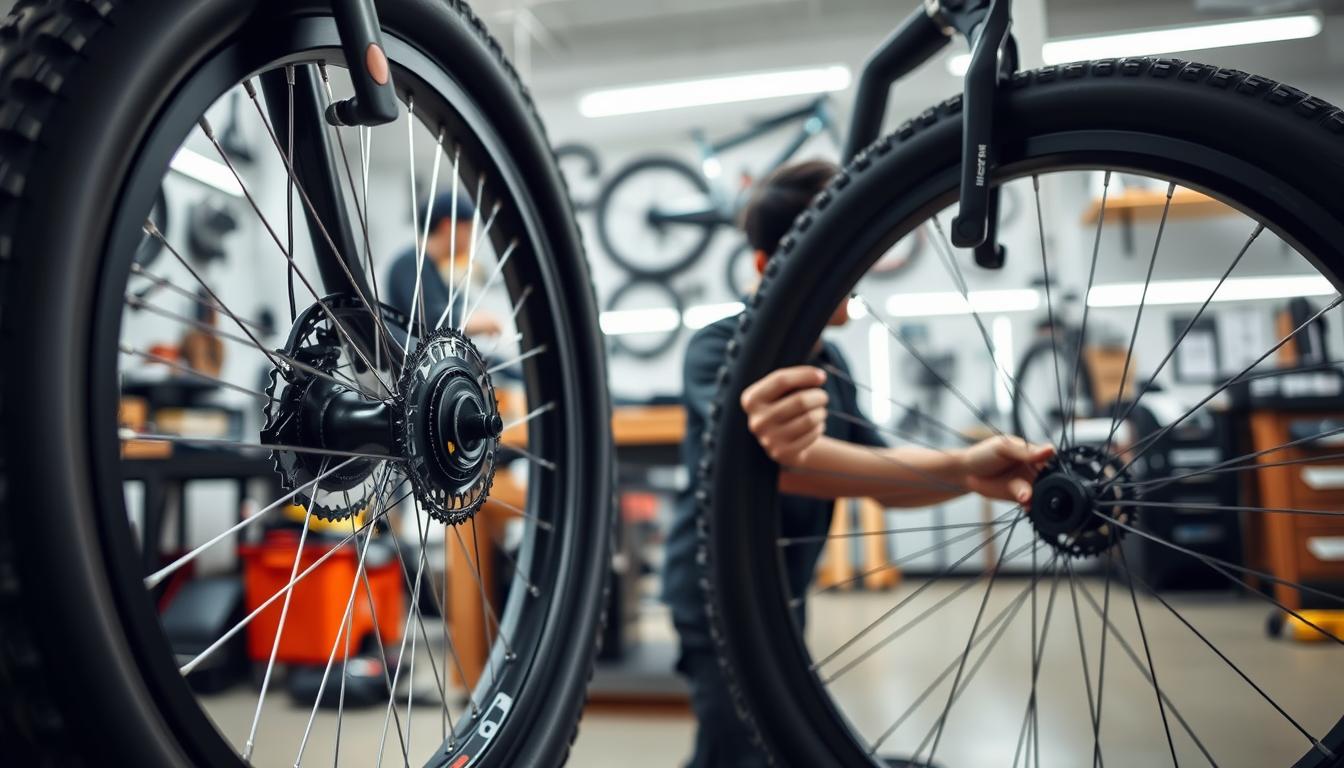Imagine cruising down a rugged trail, feeling every bump and dip beneath your wheels. Now, picture that same ride, but smoother, more controlled, and tailored to your style. That’s the power of a well-tuned suspension system. Whether you’re a casual rider or a seasoned cyclist, understanding the basics of suspension adjustment can transform your e-bike experience.
Proper suspension setup is crucial for both safety and performance. It ensures your ride is comfortable, responsive, and efficient. This guide will walk you through the essentials, covering front and rear suspension adjustments, including air pressure, rebound, and compression settings1.
Designed for riders of all levels, this step-by-step guide simplifies the process. You’ll learn about the tools you need, like a shock pump and tape measure, and how to achieve the perfect balance between performance and comfort2. Let’s dive in and make your next ride your best one yet!
Understanding EV Bike Suspension Systems
A smooth ride starts with understanding the mechanics behind your vehicle’s suspension system. Whether you’re navigating city streets or tackling rugged trails, the right setup ensures comfort, control, and safety. Let’s break down the key components and their roles in enhancing your ride.
Anatomy of Front and Rear Suspension
The front suspension, often referred to as the fork, is a critical component. It consists of stanchions that house either a coil or air spring. Coil springs are durable and cost-effective, while air springs are lighter and offer smoother performance3. The rear shock, on the other hand, works in tandem with the front fork to absorb impacts and maintain stability.
Modern designs, like those found in Magnum Bikes, feature independent systems for both front and rear wheels. This setup ensures better traction and control, especially on uneven terrains4. Understanding these parts is essential before making any adjustments.
How Suspension Enhances Ride Comfort and Control
Suspension systems are designed to absorb road bumps and reduce fatigue. The air pressure in the fork and shock plays a significant role in this process. Properly calibrated pressure ensures optimal performance, while low pressure can lead to reduced shock absorption3.
Additionally, features like lockout mechanisms eliminate unnecessary travel on smooth surfaces, conserving energy4. Hydraulic dampers further enhance control by minimizing bounce and maintaining stability. Regular maintenance, including cleaning and lubrication, keeps these components functioning at their best.
| Component | Function | Key Feature |
|---|---|---|
| Front Fork | Absorbs front wheel impacts | Coil or air spring |
| Rear Shock | Stabilizes rear wheel | Hydraulic damper |
| Air Pressure | Controls suspension stiffness | Adjustable for terrain |
By mastering the basics of your suspension system, you can tailor your ride to match your style and terrain. This knowledge sets the stage for the step-by-step adjustments we’ll explore in the next section.
How to adjust EV bike suspension
Achieving the perfect ride starts with proper preparation and the right tools. Before diving into adjustments, ensure your vehicle is stable and you have the necessary equipment. A shock pump, tape measure, and a clean workspace are essential for this process5.
Preparing Your Bike and Tools
Start by placing your vehicle on a flat surface. Gather your tools, including a shock pump and tape measure. Cleaning the stanchions and rubber seals is recommended to maintain optimal performance6. A clean rag and mild cleaning solution are suggested for this task.
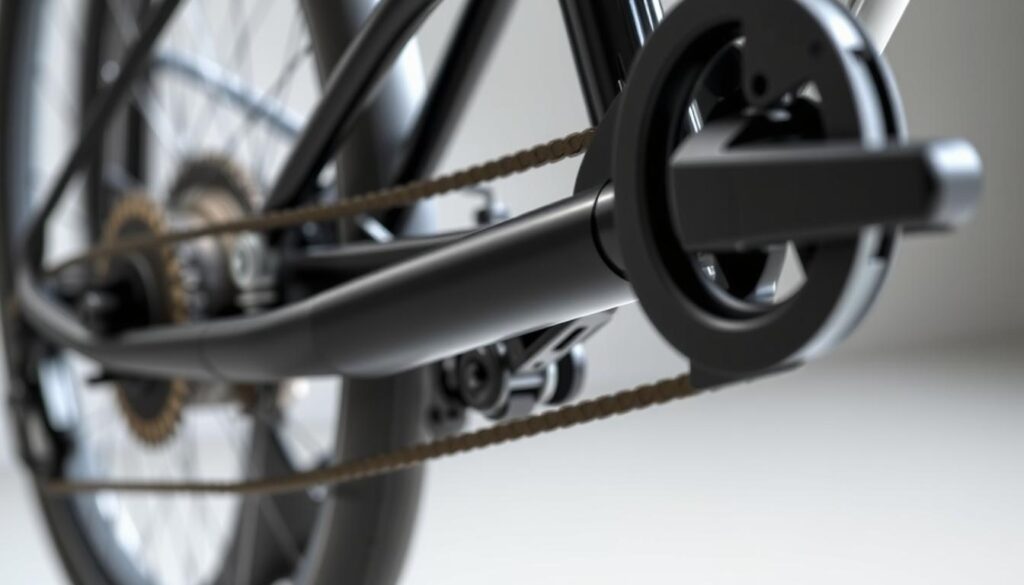
Step-by-Step Adjustments for Air Pressure, Rebound, and Compression
Begin with air pressure. Start at 150 psi and adjust based on the o-ring movement. This ensures proper shock absorption and responsiveness5. Next, focus on rebound settings. Use the “rabbit and turtle” analogy to find the optimal speed for your suspension fork.
Compression settings are equally important. Lock out the suspension for smooth roads or open it for rough trails. This adjustment enhances control and comfort6. Remember, these settings should be tailored to your riding style and the terrain you’ll be navigating.
Tips for Front Fork and Rear Shock Settings
For the front fork, ensure the preload knob is adjusted correctly. Turning it clockwise stiffens the fork, while counterclockwise increases shock absorption6. The rear shock should be calibrated to match the front fork’s settings for balanced performance.
- Measure shock absorption and wheel compression percentages for accuracy.
- Take notes during adjustments to track changes and find the perfect balance.
- Consider having a friend assist to ensure stability and precision.
Regular maintenance of the suspension system can enhance performance, indicating a direct correlation between adjustment frequency and efficiency5. By following these steps, you’ll achieve a ride that’s smooth, controlled, and tailored to your needs.
Fine-Tuning for Various Terrains and Riding Styles
Every terrain demands a unique approach to suspension tuning for the best ride experience. Whether you’re navigating city streets or tackling rugged trails, the right setup ensures comfort, control, and safety. Let’s explore how to optimize your system for different conditions.
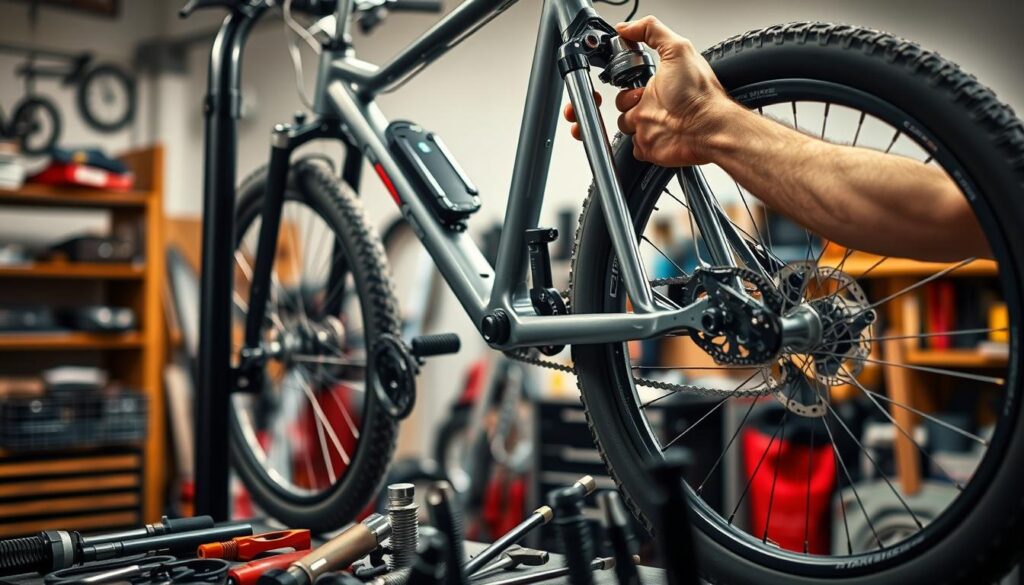
Optimizing Suspension for City Riding and Roads
For urban commuting, a firmer setup is ideal. Reducing travel to around 120mm ensures efficiency on smooth surfaces7. Adjust sag settings to 20% for Cross-Country (XC) riding, maintaining an upright geometry and reducing fatigue7.
Weight distribution plays a key role. Ensure the front and rear parts of the suspension system are balanced for stability. Locking out the suspension on flat roads conserves energy and enhances control8.
Adjustments for Off-Road and Trail Performance
Off-road adventures require a more flexible setup. Increase travel to more than 120mm for better shock absorption on rough terrains7. Sag settings of 25-30% are ideal for All-Mountain riding, balancing bump absorption and efficiency7.
For downhill descents, aim for 30% sag to maximize traction and control7. Adjust compression damping to handle high-speed impacts, ensuring the system remains responsive8.
Regularly fine-tuning each part of the suspension system ensures optimal performance. Small adjustments in travel and sag can lead to significant improvements in ride quality and control7.
Maintenance Tips for Long-Lasting Suspension Performance
Keeping your ride smooth and reliable requires consistent care and attention to your suspension system. Regular maintenance not only enhances performance but also extends the life of your components. Let’s explore some essential practices to keep your system in top shape.
Regular Cleaning and Lubrication Practices
Dirt and grime can impair the absorption capabilities of your suspension. After each ride, clean the stanchions and seals with a mild cleaning solution and a soft cloth. This prevents buildup that could affect performance9.
Lubrication is equally important. Apply a high-quality lubricant to the seals and moving parts to ensure smooth operation. Avoid over-lubrication, as it can attract dirt and debris10. Regular cleaning and lubrication keep your system functioning efficiently over time.
Early Troubleshooting and Proactive Adjustments
Early detection of issues can save you from costly repairs. Inspect your suspension regularly for signs of wear, such as oil leaks or unusual compression behavior. Excessive play or noise often indicates the need for immediate attention9.
Proactive adjustments are key to maintaining optimal performance. Check the air pressure in your forks regularly, especially if you ride frequently. Adjustments based on riding conditions ensure your system remains responsive and reliable10.
| Maintenance Task | Frequency | Benefits |
|---|---|---|
| Cleaning Stanchions | After Each Ride | Prevents dirt buildup |
| Lubricating Seals | Monthly | Ensures smooth operation |
| Checking Air Pressure | Weekly | Maintains optimal compression |
| Inspecting for Wear | Every 6 Months | Early issue detection |
By following these maintenance tips, you can ensure your suspension system performs at its best, no matter the road or terrain. Regular care and timely adjustments will keep your ride smooth and safe for years to come.
Conclusion
Mastering your ride’s setup transforms every journey into a seamless adventure. Properly tuning your system ensures comfort and control, whether you’re navigating city streets or rugged trails. Using the right tools and techniques, like adjusting air pressure and rebound, enhances performance significantly11.
Regular maintenance keeps your components in top shape, extending their lifespan and improving your overall experience. From urban commutes to off-road adventures, fine-tuning your setup to match the terrain and your riding style makes all the difference12.
Experiment with different settings to find the best way to enjoy your ebike. Share your experiences and tips with fellow riders to create a community of well-informed enthusiasts. With the right adjustments, every ride becomes smoother, safer, and more enjoyable.
Source Links
- Master E-Bike Suspension: Velotric’s Expert Guide
- E-bike / mountainbike suspension setup
- E-Bike Suspension: A Comprehensive Guide to a Smoother Ride
- A Comprehensive Guide To Electric Bike Suspension
- Simple DIY Electric Bikes Suspension Adjustments for Optimal Performan – Magicycle Bike
- How To Adjust Your Front Suspension Fork
- Perfecting E-Bike Suspension: A Comprehensive Guide
- How to adjust the suspension on an off-road electric bike?
- A Comprehensive Guide to Maintaining the Rear Suspension of a Full-Suspension Mountain eBike for Long-Lasting Optimal Performance
- How to Maintain Your E-Bike’s Suspension Front Fork for a Smooth Ride
- How to Set your EBikes Suspension – Bakcou
- E-Bike Suspension: What You Should Know Before Choosing Your Bike
